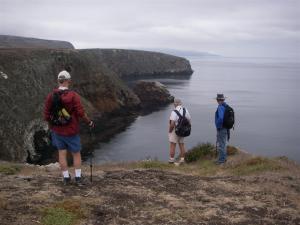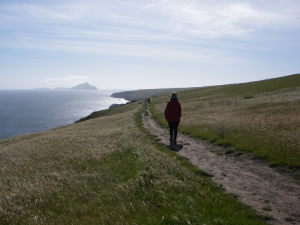-by Jay Murdock, SDKC Safety Editor
Every year in the US someone takes a tragic fall while hiking along high cliffs. In 2004 there were 82 deaths in this country from cliff falls. In 2010 a hiker on Santa Cruz Island fell 60 ft and died while hiking near Potato Harbor. Going on a “fun” hike causes us to let down our guard, diminishing the danger in our minds. The lessons learned from Mountaineering and mountain safety can be applied to hiking along cliffs, increasing the margin of safety for the casual hiker in any setting.
The cliffs on Santa Cruz Island are over 250 ft high, with unstable and slippery edges along the precipice. Steep slopes leading down to these edges increase the hazard to the hiker in several areas, making an approach to the edge a dangerous situation. Wind and water add to this danger. People have lost their balance due to slipping on loose sand, mud, wet grass, or the wind blowing them off balance. When you are thrown off balance the reaction is to take a quick step, which may cause slippage. Once slippage occurs and your body is in motion, you are in trouble. It happens in the blink of an eye.
TAKING PRECAUTIONS
- Look for expansion cracks in the ground which run parallel to the edge, and stay behind these cracks. The cliffs are always in a state of exfoliation (shedding unstable slabs of rock and dirt from the faces), and you need to be aware of these areas. Any recent rains increase the chance of this instability.
- On flat surfaces with a slight or no wind, stay back from the edge at least the length of your body height. If a wind gust blows you toward the edge, you have that space to catch yourself. If the ground is sloping down to the edge, the distance to the edge should be double that of your height (or more, depending on the ground condition, and/or velocity of the wind). It is a mountaineering truism that people literally get blown off a mountain (and in this case, a cliff).
- If you must descend to a ledge or area close to a cliff edge, make sure there are bushes along the way to grab in case you lose your footing. If there is loose rock, sand or gravel, if the slope is steep, or if the ground is muddy or wet, do not attempt the decent. Most falls in mountain climbing occur on the decent, due partly to these factors. Because you are facing away from the hill, any slippage is made worse because you are turned the wrong way to quickly catch yourself. If you slip on the decent, turn stomach down and do a spread eagle in an attempt to catch something with your hands or toes.
- If you must look over the edge to take a photo, do so laying on your stomach, and only on flat ground. Approach that position in a crawl, and back up the same way. Have someone behind you to hold your foot, just for added safety.
- Never run along a cliff edge. Tripping, slipping, or a gust of wind can quickly send you over the edge, even when that edge is some distance away from you. As in stopping a car, the faster you are going, the more distance it takes to stop yourself.
Santa Cruz Island is a beautiful place. Enjoy it safely.
– contributed by Jay Murdock


